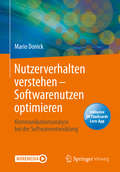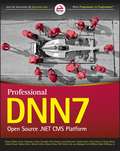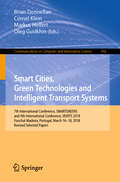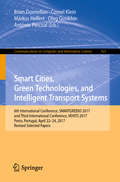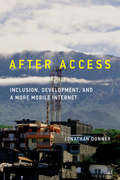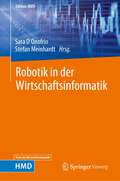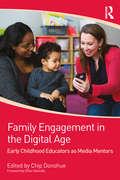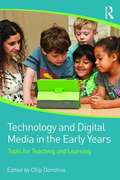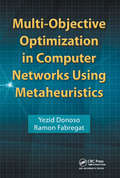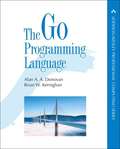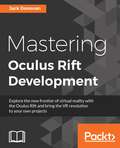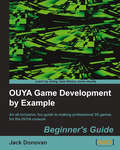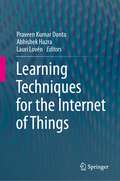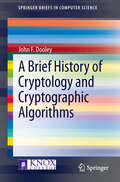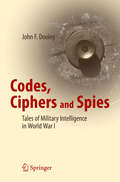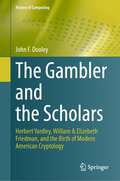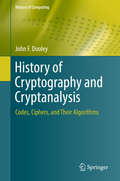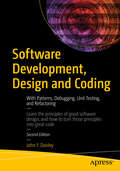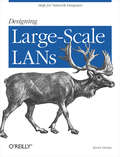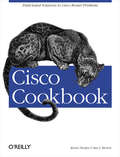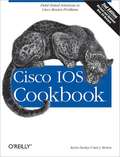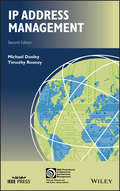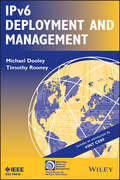- Table View
- List View
Nutzerverhalten verstehen – Softwarenutzen optimieren: Kommunikationsanalyse bei der Softwareentwicklung
by Mario DonickSoftware muss nicht nur technische Definitionen, Standards und Normen erfüllen, sondern von ihren Benutzern auch entsprechend wahrgenommen werden. Nutzer und Käufer erwarten eine bestimmte Leistung, die zu den eigenen Zielen passen muss und es ist Aufgabe der Softwareentwickler, diese Leistung zu liefern.Da es hierbei nie eine vollständige Passung geben kann, entsteht ein Kommunikationsproblem – ein Kommunikationsproblem zwischen Menschen, das noch zu selten ernstgenommen wird. Über bekannte Ansätze hinausgehend zeigt das Buch anhand vieler praxisnaher Beispiele ein Verfahren, mit dem Sie Kommunikationsprobleme während der Entwicklung von Software aufdecken und bearbeiten und mit dem Sie auch nach der Veröffentlichung Ihrer Software Möglichkeiten der Optimierung identifizieren können.Zusätzliche Fragen per App: Laden Sie die Springer Nature Flashcards-App kostenlos herunter und nutzen Sie exklusives Zusatzmaterial, um an weiteren Beispielen zu üben und Ihr Wissen zu prüfen.
Professional DNN7
by Peter Donker Israel Martinez Chris Paterra Bruce Chapman Will Strohl Shaun Walker Cathal Connolly Nathan Rover Erik Van Ballegoij Scott Willhite Ralph Williams Jr. Charles Nurse Ashish Prasad Clinton Bland Dennis Shiao Mitchel Sellersthe core of the DNN solution. All of these enhancements provide developers with a lot of power in one solution.In previous Professional DotNetNuke books, DotNetNuke founder Shaun Walker authored a popular introductory chapter covering the evolution of the DNN open source project. He will expand this initial chapter with information about venture capital funding, commercialization, and software business insights - which will be of interest to DNN enthusiasts as well as technology entrepreneurs.DNN site builders, administrators, and developers will learn how to:determine if they have met the installation requirments and install DNNadminister and host a DNN site and install and configure modulesmanage users and keep a DNN installation securelocalize a DNN site for multiple languagesbuild custom DNN modules in C# using the model of separation of database, business logic, and presentation layerscustomize the DNN look with skinningmake their site social with EVOQ
Smart Cities, Green Technologies and Intelligent Transport Systems: 7th International Conference, SMARTGREENS, and 4th International Conference, VEHITS 2018, Funchal-Madeira, Portugal, March 16-18, 2018, Revised Selected Papers (Communications in Computer and Information Science #992)
by Brian Donnellan Cornel Klein Markus Helfert Oleg GusikhinThis book constitutes the thoroughly refereed post-conference proceedings of the 7th International Conference on Smart Cities and Green ICT Systems, SMARTGREENS 2018, and the 4th International Conference on Vehicle Technology and Intelligent Transport Systems, VEHITS 2018, held in Funchal-Madeira, Portugal in March 2018.The 18 full papers presented during SMARTGREENS 2018 and VEHITS 2018 were carefully reviewed and selected from numerous submissions. The papers reflect topics such as smart cities and green ICT systems; vehicle technology and intelligent transport systems.
Smart Cities, Green Technologies, and Intelligent Transport Systems: 6th International Conference, SMARTGREENS 2017, and Third International Conference, VEHITS 2017, Porto, Portugal, April 22-24, 2017, Revised Selected Papers (Communications in Computer and Information Science #921)
by Brian Donnellan Cornel Klein Markus Helfert Oleg Gusikhin António PascoalThis book constitutes the thoroughly refereed post-conference proceedings of the 5th International Conference on Smart Cities and Green ICT Systems, SMARTGREENS 2017, and the Third International Conference on Vehicle Technology and Intelligent Transport Systems, VEHITS 2017, held in Porto, Portugal in April 2017.The 8 full papers of SMARTGREENS 2017 presented were carefully reviewed and selected from 70 submissions. VEHITS 2017 received 77 paper submissions from which 9 papers were selected and published in this book. The papers reflect topics such as smart cities, energy-aware systems and technologies, sustainable computing and communications, sustainable transportation and smart mobility.
After Access: Inclusion, Development, and a More Mobile Internet (The Information Society Series)
by Jonathan DonnerAn expert considers the effects of a more mobile Internet on socioeconomic development and digital inclusion, examining both potentialities and constraints.Almost anyone with a $40 mobile phone and a nearby cell tower can get online with an ease unimaginable just twenty years ago. An optimistic narrative has proclaimed the mobile phone as the device that will finally close the digital divide. Yet access and effective use are not the same thing, and the digital world does not run on mobile handsets alone. In After Access, Jonathan Donner examines the implications of the shift to a more mobile, more available Internet for the global South, particularly as it relates to efforts to promote socioeconomic development and broad-based inclusion in the global information society.Drawing on his own research in South Africa and India, as well as the burgeoning literature from the ICT4D (Internet and Communication Technologies for Development) and mobile communication communities, Donner introduces the “After Access Lens,” a conceptual framework for understanding effective use of the Internet by those whose “digital repertoires” contain exclusively mobile devices. Donner argues that both the potentialities and constraints of the shift to a more mobile Internet are important considerations for scholars and practitioners interested in Internet use in the global South.
Robotik in der Wirtschaftsinformatik (Edition HMD)
by Sara D’Onofrio Stefan MeinhardtMit diesem Buch führen die HerausgeberInnen den Begriff „Robotik“ in der Wirtschaftsinformatik ein. Darunter sind Lösungen zu verstehen, die den Menschen in seinen Aktivitäten unterstützt und bestehende Geschäftsprozesse durch Automatisierung optimiert. Dabei werden die Integration und Interaktion von Robotern in Informationssystemen sowie mit den Menschen adressiert und weniger die Konstruktion eines Roboters. Nebst den theoretischen Grundlagen widmet sich das Herausgeberwerk der Vielfalt verschiedener Anwendungsmöglichkeiten.Unterschiedliche Fallbeispiele geben Einblick in die Anwendung von Robotic Process Automation, Chatbots, Servicerobotern und weiteren Robotik-Lösungen und dessen Nutzenpotenziale. Das Werk richtet sich gleichermaßen an Studierende, Fachleute aller Fachrichtungen als auch den interessierten AnwenderInnen. Es hilft der Leserin und dem Leser, die Bedeutungsvielfalt des Begriffs Robotik in der Wirtschaftsinformatik zu verstehen und verschiedene Einsatzmöglichkeiten im eigenen Umfeld zu erkennen und zu bewerten.Der InhaltGrundlagenRobotic Process AutomationChatbotsServiceroboterWeitere AnwendungsfälleDie ZielgruppenCIO / CxO; Führungskräfte aus den Unternehmensbereichen, Unternehmens- und IT-BeraterInnen, ExpertInnen im Bereich Wirtschaftsinformatik, BWL und IT, interessierte AnwenderInnen, Studierende der WirtschaftsinformatikDas Herausgeber-Team Sara D'Onofrio ist IT Business Partner und Innovation Manager eines der größten Detailhandelsunternehmen der Schweiz, Autorin und Herausgeberin der Zeitschrift HMD Praxis der Wirtschaftsinformatik bei Springer und Gastdozentin an Hochschulen. Zu ihren ehrenamtlichen Tätigkeiten zählen ihr Engagement für die Stiftung FMsquare, die Unterstützung als Expertin beim Smart City Verein Bern sowie als Advisor beim NGO Spring A-C-T. Sie hat Betriebswirtschaft und Wirtschaftsinformatik studiert und in Informatik promoviert.Stefan Meinhardt ist SAP Mitarbeiter im Vorruhestand, wirkt aber weiterhin aktiv als Partner und Senior Advisor bei der dr. Fuchs Senior Advisors GmbH und berät SAP-Kunden und -Partner in strategischen Fragestellungen rund um die Themen: Digital Business Transformation, Business Model bzw. Process Innovations, Business Development, Sales & Consulting Management sowie IT Program and Project Management. Als VP und Bereichsleiter im SAP Sales sowie in der SAP Digital Business Service Organisation leitete er über viele Jahre die Beratungseinheiten für die Branchen Konsumgüter, Handel, Chemie, Pharma und Life Science sowie die Service-Industrien.
Family Engagement in the Digital Age: Early Childhood Educators as Media Mentors
by Chip DonohueFamily Engagement in the Digital Age: Early Childhood Educators as Media Mentors explores how technology can empower and engage parents, caregivers and families, and the emerging role of media mentors who guide young children and their families in the 21st century. This thought-provoking guide to innovative approaches to family engagement includes Spotlight on Engagement case studies, success stories, best practices, helpful hints for media mentors, and "learn more" resources woven into each chapter to connect the dots between child development, early learning, developmentally appropriate practice, family engagement, media mentorship and digital age technology. In addition, the book is driven by a set of best practices for teaching with technology in early childhood education that are based on the National Association for the Education of Young Children (NAEYC) and Fred Rogers Center joint position statement on Technology and Interactive Media. Please visit the Companion Website at http://teccenter.erikson.edu/family-engagement-in-the-digital-age
Technology and Digital Media in the Early Years: Tools for Teaching and Learning
by Chip DonohueThis book provides strategies, theoretical frameworks, links to research evidence, descriptions of best practice, and resources to develop essential digital literacy knowledge, skills, and experiences for early childhood educators in the digital age.
Multi-Objective Optimization in Computer Networks Using Metaheuristics
by Yezid Donoso Ramon FabregatMetaheuristics are widely used to solve important practical combinatorial optimization problems. Many new multicast applications emerging from the Internet-such as TV over the Internet, radio over the Internet, and multipoint video streaming-require reduced bandwidth consumption, end-to-end delay, and packet loss ratio. It is necessary to design an
The Go Programming Language
by Alan A. A. Donovan Brian W. KernighanThe Go Programming Language is the authoritative resource for any programmer who wants to learn Go. It shows how to write clear and idiomatic Go to solve real-world problems. The book does not assume prior knowledge of Go nor experience with any specific language, so you’ll find it accessible whether you’re most comfortable with JavaScript, Ruby, Python, Java, or C++. <p><p> The book features hundreds of interesting and practical examples of well-written Go code that cover the whole language, its most important packages, and a wide range of applications. Each chapter has exercises to test your understanding and explore extensions and alternatives. Source code is freely available for download from http://gopl.io/ and may be conveniently fetched, built, and installed using the go get command.
Mastering Oculus Rift Development
by Jack DonovanExplore the new frontier of virtual reality with the Oculus Rift and bring the VR revolution to your own projects About This Book • Create immersive 3D games especially designed for the Oculus Rift platform • Build complex realistic virtual reality (VR) games with the Unity Engine • Create striking VR environments with advanced graphical techniques Who This Book Is For This book is for aspiring indie developers and VR enthusiasts who want to bring their ideas into virtual reality with a new platform that provides an unprecedented level of realism and immersion. What You Will Learn • Increase immersion with 3D audio and intuitive interfaces • Create group VR experiences using multi-player networking • Design fun and engaging mechanics that utilize VR principles • Explore the best ways to navigate and interact using the Oculus Rift • Design intuitive ways to navigate and interact with scenes in VR • Add stunning realism to a scene with three-dimensional audio • Invent mechanics and features that take full advantage of VR hardware In Detail Virtual reality (VR) is changing the world of gaming and entertainment as we know it. VR headsets such as the Oculus Rift immerse players in a virtual world by tracking their head movements and simulating depth, giving them the feeling that they are actually present in the environment. We will first use the Oculus SDK in the book and will then move on to the widely popular Unity Engine, showing you how you can add that extra edge to your VR games using the power of Unity. In this book, you'll learn how to take advantage of this new medium by designing around each of its unique features. This book will demonstrate the Unity 5 game engine, one of most widely-used engines for VR development, and will take you through a comprehensive project that covers everything necessary to create and publish a complete VR experience for the Oculus Rift. You will also be able to identify the common perils and pitfalls of VR development to ensure that your audience has the most comfortable experience possible. By the end of the book, you will be able to create an advanced VR game for the Oculus Rift, and you'll have everything you need to bring your ideas into a new reality. Style and approach This book takes a step-by-step tutorial approach with illustrative examples to help you implement the projects on your own. The book lets you first get to grips with the Oculus SDK and then moves on to the Unity Engine to add realistic graphics and features in your games.
OUYA Game Development by Example
by Jack Donovan"OUYA Game Development by Example" consists of different game application examples. No prior experience with programming is required. You will learn everything from scratch and will have an organized flow of information specifically designed for complete beginners. Using this book, you can get started with creating games without any game development experience. This book is perfect for anyone that wants to make video games but is unsure of where to start. It covers elements of game design, art, and programming comprehensively, and the engine used throughout all of the tutorials is very beginner-friendly. No prior knowledge is assumed or required for the tutorials in this book.
Profit and Prejudice: The Luddites of the Fourth Industrial Revolution
by Paul DonovanAvoiding prejudice will be critical to economic success in the fourth industrial revolution. It is not the new and innovative technology that will matter in the next decade, but what we do with it. Using technology properly, with diverse decision making, is the difference between success and failure in a changing world. This will require putting the right person in the right job at the right time. Prejudice stops that happening. Profit and Prejudice takes us through the relationship between economic success and prejudice in labour markets. It starts with the major changes that occur in periods of economic upheaval. These changes tend to be unpopular and complex – and complexity encourages people to turn to the simplistic arguments of ‘scapegoat economics’ and prejudice. Some of the changes of the fourth industrial revolution will help fight prejudice, but some will make it far worse. The more prejudice there is, the harder it will be for companies and countries to profit from the changes ahead. Profit is not the main argument against prejudice, but can certainly help fight it. This book tells a story of the damage that prejudice can do. Using economics without jargon, students, investors and the public will be able to follow the narrative and see how prejudice can be opposed. Prejudice is bad for business and the economy. Profit and Prejudice explains why.
Learning Techniques for the Internet of Things
by Praveen Kumar Donta Abhishek Hazra Lauri LovénThe book is structured into thirteen chapters; each comes with its own dedicated contributions and future research directions. Chapter 1 introduces IoT and the use of Edge computing, particularly cloud computing, and mobile edge computing. This chapter also mentions the use of edge computing in various real-time applications such as healthcare, manufacturing, agriculture, and transportation. Chapter 2 motivates mathematical modeling for federated learning systems with respect to IoT and its applications. Further Chapter 3 extends the discussion of federated learning for IoT, which has emerged as a privacy-preserving distributed machine learning approach. Chapter 4 provides various machine learning techniques in Industrial IoT to deliver rapid and accurate data analysis, essential for enhancing production quality, sustainability, and safety. Chapter discusses the potential role of data-driven technologies, such as Artificial Intelligence, Machine Learning, and Deep Learning, focuses on their integration with IoT communication technologies. Chapter 6 presents the requirements and challenges to realize IoT deployments in smart cities, including sensing infrastructure, Artificial Intelligence, computing platforms, and enabling communications technologies such as 5G networks. To highlight these challenges in practice, the chapter also presents a real-world case study of a city-scale deployment of IoT air quality monitoring within Helsinki city. Chapter 7 uses digital twins within smart cities to enhance economic progress and facilitate prompt decision-making regarding situational awareness. Chapter 8 provides insights into using Multi-Objective reinforcement learning in future IoT networks, especially for an efficient decision-making system. Chapter 9 offers a comprehensive review of intelligent inference approaches, with a specific emphasis on reducing inference time and minimizing transmitted bandwidth between IoT devices and the cloud. Chapter 10 summarizes the applications of deep learning models in various IoT fields. This chapter also presents an in-depth study of these techniques to examine new horizons of applications of deep learning models in different areas of IoT. Chapter 11 explores the integration of Quantum Key Distribution (QKD) into IoT systems. It delves into the potential benefits, challenges, and practical considerations of incorporating QKD into IoT networks. In chapter 12, a comprehensive overview regarding the current state of quantum IoT in the context of smart healthcare is presented, along with its applications, benefits, challenges, and prospects for the future. Chapter 13 proposes a blockchain-based architecture for securing and managing IoT data in intelligent transport systems, offering advantages like immutability, decentralization, and enhanced security.
A Brief History of Cryptology and Cryptographic Algorithms (SpringerBriefs in Computer Science)
by John F. DooleyThe science of cryptology is made up of two halves. Cryptography is the study of how to create secure systems for communications. Cryptanalysis is the study of how to break those systems. The conflict between these two halves of cryptology is the story of secret writing. For over 2,000 years, the desire to communicate securely and secretly has resulted in the creation of numerous and increasingly complicated systems to protect one's messages. Yet for every system there is a cryptanalyst creating a new technique to break that system. With the advent of computers the cryptographer seems to finally have the upper hand. New mathematically based cryptographic algorithms that use computers for encryption and decryption are so secure that brute-force techniques seem to be the only way to break them - so far. This work traces the history of the conflict between cryptographer and cryptanalyst, explores in some depth the algorithms created to protect messages, and suggests where the field is going in the future.
Codes, Ciphers and Spies: Tales of Military Intelligence in World War I
by John F. DooleyWhen the United States declared war on Germany in April 1917, it was woefully unprepared to wage a modern war. Whereas their European counterparts already had three years of experience in using code and cipher systems in the war, American cryptologists had to help in the building of a military intelligence unit from scratch. This book relates the personal experiences of one such character, providing a uniquely American perspective on the Great War. It is a story of spies, coded letters, plots to blow up ships and munitions plants, secret inks, arms smuggling, treason, and desperate battlefield messages. Yet it all begins with a college English professor and Chaucer scholar named John Mathews Manly. In 1927, John Manly wrote a series of articles on his service in the Code and Cipher Section (MI-8) of the U. S. Army's Military Intelligence Division (MID) during World War I. Published here for the first time, enhanced with references and annotations for additional context, these articles form the basis of an exciting exploration of American military intelligence and counter-espionage in 1917-1918. Illustrating the thoughts of prisoners of war, draftees, German spies, and ordinary Americans with secrets to hide, the messages deciphered by Manly provide a fascinating insight into the state of mind of a nation at war.
The Gambler and the Scholars: Herbert Yardley, William & Elizebeth Friedman, and the Birth of Modern American Cryptology (History of Computing)
by John F. DooleyIn May 1917, William and Elizebeth Friedman were asked by the U.S. Army to begin training officers in cryptanalysis and to decrypt intercepted German diplomatic and military communications. In June 1917, Herbert Yardley convinced the new head of the Army’s Military Intelligence Division to create a code and cipher section for the Army with himself as its head. These two seminal events were the beginning of modern American cryptology, the growth of which culminated 35 years later with the creation of the National Security Agency. Each running their own cryptologic agencies in the 1920s, the Friedman-Yardley relationship was shattered after Yardley published a tell-all book about his time in military intelligence. Yet in the end, the work they all started in 1917 led directly to the modern American intelligence community. As they got older, they became increasingly irrelevant in the burgeoning American cryptologic fraternity. Topics and features: * Examines the lives of three remarkable and pioneering cryptologists * Offers fascinating insights into spies, codes and ciphers, rumrunners, poker, and military history * Sheds new light on interesting parts of the cryptologists’ careers—especially Elizebeth Friedman, whose work during World War II has just begun to be explored * Recounts several good stories, i.e., What if the Friedmans had gone to work for Herbert Yardley in his new Cipher Bureau in 1919? What if Yardley had moved back to Washington to work for William Friedman a decade later? This enjoyable book has wide appeal for: general readers interested in the evolution of American cryptology, American historians (particularly of World War I, the inter-war period, and World War II signals intelligence), and historians of—and general readers interested in—American military intelligence. It also can be used as an auxiliary text or recommended reading in introductory or survey courses in history or on the related topics.
History of Cryptography and Cryptanalysis: Codes, Ciphers, and Their Algorithms (History of Computing)
by John F. DooleyThis accessible textbook presents a fascinating review of cryptography and cryptanalysis across history. The text relates the earliest use of the monoalphabetic cipher in the ancient world, the development of the “unbreakable” Vigenère cipher, and an account of how cryptology entered the arsenal of military intelligence during the American Revolutionary War. Moving on to the American Civil War, the book explains how the Union solved the Vigenère ciphers used by the Confederates, before investigating the development of cipher machines throughout World War I and II. This is then followed by an exploration of cryptology in the computer age, from public-key cryptography and web security, to criminal cyber-attacks and cyber-warfare. Looking to the future, the role of cryptography in the Internet of Things is also discussed, along with the potential impact of quantum computing.Topics and features: presents a history of cryptology from ancient Rome to the present day, with a focus on cryptology in the 20th and 21st centuries; reviews the different types of cryptographic algorithms used to create secret messages, and the various methods for breaking such secret messages; provides engaging examples throughout the book illustrating the use of cryptographic algorithms in different historical periods; describes the notable contributions to cryptology of Herbert Yardley, William and Elizebeth Smith Friedman, Lester Hill, Agnes Meyer Driscoll, and Claude Shannon; concludes with a review of tantalizing unsolved mysteries in cryptology, such as the Voynich Manuscript, the Beale Ciphers, and the Kryptos sculpture.This engaging work is ideal as both a primary text for courses on the history of cryptology, and as a supplementary text for advanced undergraduate courses on computer security. No prior background in mathematics is assumed, beyond what would be encountered in an introductory course on discrete mathematics.
Software Development, Design and Coding
by John F. DooleyLearn the principles of good software design, and how to turn those principles into great code. This book introduces you to software engineering — from the application of engineering principles to the development of software. You'll see how to run a software development project, examine the different phases of a project, and learn how to design and implement programs that solve specific problems. It's also about code construction — how to write great programs and make them work. Whether you're new to programming or have written hundreds of applications, in this book you'll re-examine what you already do, and you'll investigate ways to improve. Using the Java language, you'll look deeply into coding standards, debugging, unit testing, modularity, and other characteristics of good programs. With Software Development, Design and Coding, author and professor John Dooley distills his years of teaching and development experience to demonstrate practical techniques for great coding.What You'll LearnReview modern agile methodologies including Scrum and Lean programmingLeverage the capabilities of modern computer systems with parallel programmingWork with design patterns to exploit application development best practicesUse modern tools for development, collaboration, and source code controlsWho This Book Is ForEarly career software developers, or upper-level students in software engineering courses
Designing Large Scale Lans
by Kevin DooleyThis unique book offers a vendor-neutral approach for designing large local area networks according to business or organizational needs, rather than from a product perspective. Author and independent network design consultant Kevin Dooley outlines "top-down network design" for building a technological infrastructure to fit your organization's requirements, a process far more effective and cost-efficient than fitting the organization to the parameters of a shrink-wrapped proprietary solution. Dooley argues that the design of a network is largely independent of the products used. Whether you use a Cisco or Juniper router, the same security issues and protocols apply. The questions he addresses in this book are need-specific: Do I use a router or a switch? Should I route between switched areas or switch between routed areas? Designing Large-Scale LANs covers everything from security, bandwidth and scalability to network reliability, which includes backup, redundancy, and points of failure. Specific technologies are analyzed in detail: network topologies, routing and switching strategies, wireless, virtual LANs, firewalls and gateways, security, Internet protocols, bandwidth, and multicast services. The book also discusses proprietary technologies that are ubiquitous, such as Cisco's IOS and Novell's IPX. This complete guide to top-down network design will help you choose the right network solutions. If you're designing large scale networks and need expert advice and guidance, look no further than Designing Large-Scale LANs.
Cisco Cookbook: Field-tested Solutions To Cisco Router Problems (Cookbooks (o'reilly) Ser.)
by Kevin Dooley Ian BrownWhile several publishers (including O'Reilly) supply excellent documentation of router features, the trick is knowing when, why, and how to use these features There are often many different ways to solve any given networking problem using Cisco devices, and some solutions are clearly more effective than others. The pressing question for a network engineer is which of the many potential solutions is the most appropriate for a particular situation. Once you have decided to use a particular feature, how should you implement it? Unfortunately, the documentation describing a particular command or feature frequently does very little to answer either of these questions. Everybody who has worked with Cisco routers for any length of time has had to ask their friends and co-workers for example router configuration files that show how to solve a common problem. A good working configuration example can often save huge amounts of time and frustration when implementing a feature that you've never used before. The Cisco Cookbook gathers hundreds of example router configurations all in one place. As the name suggests, Cisco Cookbook is organized as a series of recipes. Each recipe begins with a problem statement that describes a common situation that you might face. After each problem statement is a brief solution that shows a sample router configuration or script that you can use to resolve this particular problem. A discussion section then describes the solution, how it works, and when you should or should not use it. The chapters are organized by the feature or protocol discussed. If you are looking for information on a particular feature such as NAT, NTP or SNMP, you can turn to that chapter and find a variety of related recipes. Most chapters list basic problems first, and any unusual or complicated situations last. The Cisco Cookbook will quickly become your "go to" resource for researching and solving complex router configuration issues, saving you time and making your network more efficient. It covers:Router Configuration and File Management Router Management User Access and Privilege Levels TACACS+ IP Routing RIP EIGRP OSPF BGP Frame Relay Queueing and Congestion Tunnels and VPNs Dial Backup NTP and Time DLSw Router Interfaces and Media Simple Network Management Protocol Logging Access Lists DHCP NAT Hot Standby Router Protocol IP Multicast
Cisco IOS Cookbook
by Kevin Dooley Ian BrownNever has something cried out for a cookbook quite as much as Cisco's Internetwork Operating System (IOS). IOS is powerful and flexible, but also confusing and daunting. Most tasks can be accomplished in several different ways. And you don't want to spend precious time figuring out which way is best when you're trying to solve a problem quickly. That's what this cookbook is for. Fortunately, most router configuration tasks can be broken down into several more or less independent steps: you configure an interface, you configure a routing protocol, you set up backup links, you implement packet filters and other access control mechanisms. What you really need is a set of recipes that show you how to perform the most common tasks, so you can quickly come up with a good configuration for your site. And you need to know that these solutions work: you don't want to find yourself implementing a backup link at 2 A.M. because your main link is down and the backup link you set up when you installed the router wasn't quite right.Thoroughly revised and expanded, Cisco IOS Cookbook, 2nd Edition, adds sections on MPLS, Security, IPv6, and IP Mobility, and presents solutions to the most common configuration problems, including: Configuring interfaces of many types, from serial to ATM and Frame Relay Configuring all of the common IP routing protocols (RIP, EIGRP, OSPF, and BGP) Configuring authentication Configuring other services, including DHCP and NTP Setting up backup links, and using HSRP to configure backup routers Managing the router, including SNMP and other solutions Using access lists to control the traffic through the routerIf you work with Cisco routers, you need a book like this to help you solve problems quickly and effectively. Even if you're experienced, the solutions and extensive explanations will give you new ideas and insights into router configuration. And if you're not experienced--if you've just been given responsibility for managing a network with Cisco routers--this book could be a job-saver.
Cisco IOS Cookbook
by Kevin Dooley Ian J. BrownNever has something cried out for a cookbook quite as much as Cisco's Internetwork Operating System (IOS). IOS is powerful and flexible, but also confusing and daunting. Most tasks can be accomplished in several different ways. And you don't want to spend precious time figuring out which way is best when you're trying to solve a problem quickly. That's what this cookbook is for. Fortunately, most router configuration tasks can be broken down into several more or less independent steps: you configure an interface, you configure a routing protocol, you set up backup links, you implement packet filters and other access control mechanisms. What you really need is a set of recipes that show you how to perform the most common tasks, so you can quickly come up with a good configuration for your site. And you need to know that these solutions work: you don't want to find yourself implementing a backup link at 2 A.M. because your main link is down and the backup link you set up when you installed the router wasn't quite right. Thoroughly revised and expanded, Cisco IOS Cookbook, 2nd Edition, adds sections on MPLS, Security, IPv6, and IP Mobility, and presents solutions to the most common configuration problems, including: * Configuring interfaces of many types, from serial to ATM and Frame Relay * Configuring all of the common IP routing protocols (RIP, EIGRP, OSPF, and BGP) * Configuring authentication * Configuring other services, including DHCP and NTP * Setting up backup links, and using HSRP to configure backup routers * Managing the router, including SNMP and other solutions * Using access lists to control the traffic through the router If you work with Cisco routers, you need a book like this to help you solve problems quickly and effectively. Even if you're experienced, the solutions and extensive explanations will give you new ideas and insights into router configuration. And if you're not experienced- if you've just been given responsibility for managing a network with Cisco routers- this book could be a job-saver.
IP Address Management: Principles And Practice (IEEE Press Series on Networks and Service Management #16)
by Michael Dooley Timothy RooneyRediscover fundamental and advanced topics in IPAM, DNS, DHCP and other core networking technologies with this updated one-stop reference The thoroughly revised second edition of IP Address Management is the definitive reference for working with core IP management technologies, like address allocation, assignment, and network navigation via DNS. Accomplished professionals and authors Timothy Rooney and Michael Dooley offer readers coverage of recent IPAM developments in the world of cloud computing, Internet of Things (IoT), and security, as well as a comprehensive treatment of foundational concepts in IPAM. The new edition addresses the way that IPAM needs and methods have evolved since the publication of the first edition. The book covers the impact of mainstream use of private and public cloud services, the maturation of IPv6 implementations, new DNS security approaches, and the proliferation of IoT devices. The authors have also reorganized the flow of the book, with much of the technical reference material appearing at the end and making for a smoother and simpler reading experience. The 2nd edition of IP Address Management also covers topics like such as: Discussions about the fundamentals of Internet Protocol Address Management (IPAM), including IP addressing, address allocation and assignment, DHCP, and DNS An examination of IPAM practices, including core processes and tasks, deployment strategies, IPAM security best-practices, and DNS security approaches A treatment of IPAM in the modern context, including how to adapt to cloud computing, the Internet of Things, IPv6, and new trends in IPAM A one-stop reference for IPAM topics, including IP addressing, DHCP, DNS, IPv6, and DNS security Perfect for IP network engineers and managers, network planners, network architects, and security engineers, the second edition of IP Address Management also belongs on the bookshelves of senior undergraduate and graduate students studying in networking, information technology, and computer security-related courses and programs.
IPv6 Deployment and Management (IEEE Press Series on Networks and Service Management #22)
by Michael Dooley Timothy RooneyWith the announcement in 2011 that the current Internet Protocol (IP), IPv4, has nearly run out, interest in IPv6 -- the latest IP version -- has grown substantially. This book describes IPv6 technology and its repercussions on organizations, including strategies and techniques for assessing the impact of deploying IPv6 on a network, discovering current IP assets, assessing network readiness, creating a plan to deploy IPv6 while retaining IPv4 connectivity, and for managing a dual protocol IPv4-IPv6 network. It is a must read for IP network engineers, managers, and those who work in IT.
